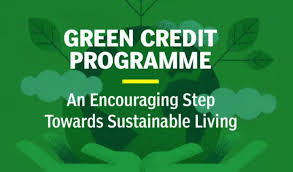
Green Credit Program (GCP)
Green Credit Program (GCP)
GS-2,3: Government policies and interventions; Renewable energy
(IAS/UPPCS)
Relevant for Prelims:
Green Credit Program (GCP), Ministry of Environment, Forest and Climate Change (MoEF&CC), Indian Council of Forestry Research and Education (ICFRE), Lifestyle for the Environment or 'LiFE' movement, COP 28, COP 26.
Relevant for Mains:
About Green Credit Program (GCP), Importance, Challenges, Way Forward.
19/04/2024
Source: TH
Why in news:
Recently, the Union Environment Ministry has made significant changes in the norms of the Green Credit Program (GCP).
- According to the recent data of the Central Government, Madhya Pradesh is leading in implementing tree plantation through Green Credit Programme. After this are Telangana, Chhattisgarh, Gujarat and Assam.
- GCP has approved plantation in more than 500 lands covering 4,980 hectares in 10 states in the last two months.
Points related to significant changes:
- Amid concerns that the GCP may encourage tree planting for financial gain, the government has clarified that priority should be given to restoring ecosystems rather than mere tree planting.
- Indigenous species will be given priority and naturally growing plants will be retained.
- The ministry has changed the earlier requirement that there should be a minimum of 1,100 trees per hectare to qualify as reforested landscape and left the responsibility of specifying them to the states.
- Actual afforestation will be done by state forest departments.
About Green Credit Program (GCP):
- It is an innovative initiative launched by the Ministry of Environment, Forest and Climate Change (MoEF&CC).
- The program was launched by the Indian Prime Minister on the occasion of COP 28 (to be held in Expo City, Dubai, and UAE in 2023).
- It is an initiative under the Lifestyle for the Environment (LiFE) movement of the government.
- The concept of Life was launched by the Indian Prime Minister at COP26 (Glasgow) in 2021, to drive an international mass movement towards “careful and deliberate use” to protect and conserve the environment.
- Goal: It aims to create a market-based mechanism to encourage 'voluntary environmental actions' by individuals, urban local bodies, communities and the private sector.
Its main objectives sector wise:
Plantation-Based Green Credit:
- To promote activities to increase green cover across the country through tree plantation and related activities.
Water-Based Green Credits:
- To promote water conservation, water harvesting and water use efficiency/savings, including treatment and re-use of waste water.
Sustainable Agriculture-Based Green Credit:
- Promote natural and regenerative agricultural practices and land restoration to improve productivity, soil health and nutritional value of food produced.
Waste Management-Based Green Credit:
- Promoting sustainable and improved practices for waste management including collection, separation and treatment.
Air pollution reduction-based green credits:
- To promote measures to reduce air pollution and other pollution-prevention activities.
Mangrove Conservation and Restoration-Based Green Credit:
- Promote mangrove conservation and restoration measures.
Ecomark-Based Green Credit:
- To encourage manufacturers to obtain eco-mark labels for their goods and services.
Green Credit based on sustainable buildings and infrastructure:
- Encouraging construction of buildings and other infrastructure using sustainable technologies and materials.
Implementation of GCP:
- The governance structure of the GCP is supported by an Inter-Ministerial Steering Committee and the Indian Council of Forestry Research and Education (ICFRE) acts as the GCP Administrator, responsible for program implementation, management, monitoring and operations.
- A user-friendly digital platform will streamline the processes of registration of projects, its verification and issuance of green credits.
- The Green Credit Registry and Trading Platform, being developed by ICFRE with experts, will facilitate registration and subsequent purchase and sale of green credits.
- To obtain green credits, individuals and entities must register their activities with the government.
- The Administrator will verify the activity through a designated agency, with self-verification for smaller projects.
Impact of GCP:
- GCP aims to incentivize environmentally positive actions and generate green credit through a market-based mechanism, which will be tradable and made available for trading on the domestic market platform.
- It states that if generating green credits significantly reduces or removes carbon emissions, they can also be used to obtain carbon credits.
Significance of GCP:
- It is the first program of its kind that seeks to value and reward multiple ecosystem services to allow green projects to achieve returns beyond carbon.
- The scheme will allow project proponents to additionally access carbon markets.
- The program will encourage private sector industries and companies as well as other entities to meet their existing obligations arising from other legal frameworks that are able to engage with relevant activities to generate or purchase green credits.
- This program will be very helpful for organic agriculture farmers and FPOs.
Challenges:
- The goals and objectives of this program are of good nature but to achieve them, the implementation of the standards of this program is very challenging.
- The reason for this is the difficulty in establishing similarity between different actions.
- For example, it is difficult to establish how much water one saved, and how much emissions it reduced.
- The program also faces challenges related to monitoring, reporting and verification.
Way forward:
- There is a need to build capacity to monitor these systems and prevent fraud.
- This will save resources that can be used for more transformative pollution control and biodiversity conservation efforts.
- The methodology, standards and strategies of the program should meet market feasibility and adequate demand for green credit.
- In evaluating and implementing green credit systems, special attention should be given to tree planting and afforestation to mitigate climate change related challenges.
-------------------------------------------
Mains Question
‘Green Credit Program is a unique initiative of the Government of India under the Lifestyle (LiFE) movement. Discuss.